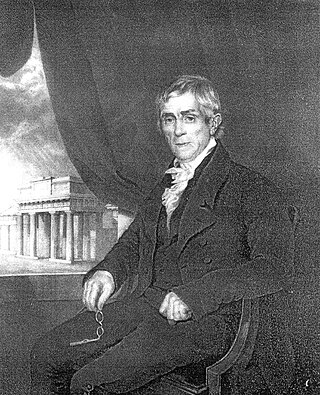
Egyptian Revival is an architectural style that uses the motifs and imagery of ancient Egypt. It is attributed generally to the public awareness of ancient Egyptian monuments generated by Napoleon's conquest of Egypt and Admiral Nelson's defeat of the French Navy at the Battle of the Nile in 1798. Napoleon took a scientific expedition with him to Egypt. Publication of the expedition's work, the Description de l'Égypte, began in 1809 and was published as a series through 1826. The size and monumentality of the façades discovered during his adventure cemented the hold of Egyptian aesthetics on the Parisian elite. However, works of art and architecture in the Egyptian style had been made or built occasionally on the European continent since the time of the Renaissance.
The year 1902 in architecture involved some significant events.
The year 1926 in architecture involved some significant architectural events and new buildings.
The year 1932 in architecture involved some significant events.
The year 1819 in architecture involved some significant architectural events and new buildings.
The year 1847 in architecture involved some significant architectural events and new buildings.
The year 1764 in architecture involved some significant events.
The year 1822 in architecture involved some significant events.
The year 1891 in architecture involved some significant architectural events and new buildings.

Thomas Harrison was an English architect and bridge engineer who trained in Rome, where he studied classical architecture. Returning to England, he won the competition in 1782 for the design of Skerton Bridge in Lancaster. After moving to Lancaster he worked on local buildings, received commissions for further bridges, and designed country houses in Scotland. In 1786 Harrison was asked to design new buildings within the grounds of Lancaster and Chester castles, projects that occupied him, together with other works, until 1815. On both sites he created accommodation for prisoners, law courts, and a shire hall, while working on various other public buildings, gentlemen's clubs, churches, houses, and monuments elsewhere. His final major commission was for the design of Grosvenor Bridge in Chester.

Thomas Archer (1668–1743) was an English Baroque architect. His buildings are important as the only ones by an English Baroque architect to show evidence of study of contemporary continental, namely Italian, architecture.
The year 1825 in architecture involved some significant architectural events and new buildings.
The year 1699 in architecture involved some significant architectural events and new buildings.
The year 1762 in architecture involved some significant events.
The year 1700 in architecture involved some significant events.
The year 1770 in architecture involved some significant events.
The year 1790 in architecture involved some significant architectural events and new buildings.

Francis Smith of Warwick (1672–1738) was an English master-builder and architect, much involved in the construction of country houses in the Midland counties of England. Smith of Warwick may refer also to his brothers, or his son.

The Shire Hall, Monmouth, Wales, is a prominent building on Agincourt Square in the town centre. It was built in 1724, and was formerly the centre for the Assize Courts and Quarter Sessions for Monmouthshire. The building was also used as a market place. In 1839–40, the court was the location of the trial of the Chartist leader John Frost and others for high treason for their part in the Newport Rising.

George Vaughan Maddox was a nineteenth-century British architect and builder, whose work was undertaken principally in the town of Monmouth, Wales, and in the wider county. Working mainly in a Neo-Classical style, his extensive output made a significant contribution to the Monmouth townscape. The architectural historian John Newman considers that Monmouth owes to Maddox "its particular architectural flavour. For two decades from the mid-1820s he put up a sequence of public buildings and private houses in the town, in a style deft, cultured, and only occasionally unresolved." The Market Hall and 1-6 Priory Street are considered his "most important projects".






